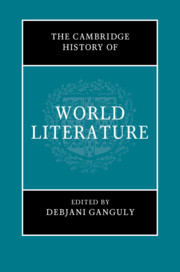Book contents
- The Cambridge History of World Literature
- The Cambridge History of World Literature
- Copyright page
- Contents
- Figures
- Contributors
- Acknowledgements
- Introduction
- Part I Genealogies
- Part II Thinking the World
- Part III Transregional Worlding
- Part IV Cartographic Shifts
- Part V World Literature and Translation
- Part VI Poetics, Genre, Intermediality
- 31 Poetry, (Un)Translatability, and World Literature
- 32 The Reinvention of the Novel in Africa
- 33 The Return of Realism in the World Novel
- 34 The Graphic Novel as an Intermedial Form
- 35 World Children’s Literature
- Part VII Scales, Polysystems, Canons
- Part VIII Modes of Reading and Circulation
- Part IX The Worldly and the Planetary
- Index
- References
31 - Poetry, (Un)Translatability, and World Literature
from Part VI - Poetics, Genre, Intermediality
Published online by Cambridge University Press: 17 August 2021
- The Cambridge History of World Literature
- The Cambridge History of World Literature
- Copyright page
- Contents
- Figures
- Contributors
- Acknowledgements
- Introduction
- Part I Genealogies
- Part II Thinking the World
- Part III Transregional Worlding
- Part IV Cartographic Shifts
- Part V World Literature and Translation
- Part VI Poetics, Genre, Intermediality
- 31 Poetry, (Un)Translatability, and World Literature
- 32 The Reinvention of the Novel in Africa
- 33 The Return of Realism in the World Novel
- 34 The Graphic Novel as an Intermedial Form
- 35 World Children’s Literature
- Part VII Scales, Polysystems, Canons
- Part VIII Modes of Reading and Circulation
- Part IX The Worldly and the Planetary
- Index
- References
Summary
What is the place of poetry in world literature? World literature has been defined as writing as gains in translation, but this model excludes poetry tied to the language in which it is written. Poetry has also been said to be untranslatable, but this opposing model can’t account for the aspects of poetry that survive and even thrive in translation. Exploring lyrics in Persian, German, Latin, French, and code-switching English, this chapter tests the “gains-in-translation” and “untranslatability” models against poetry’s language-specific and language-crossing affordances. Proposing a more nuanced position that allows for both losses and gains, it argues that world literature can only be adequate to poetry if it’s attentive to comparative literary specificity.
- Type
- Chapter
- Information
- The Cambridge History of World Literature , pp. 587 - 620Publisher: Cambridge University PressPrint publication year: 2021



